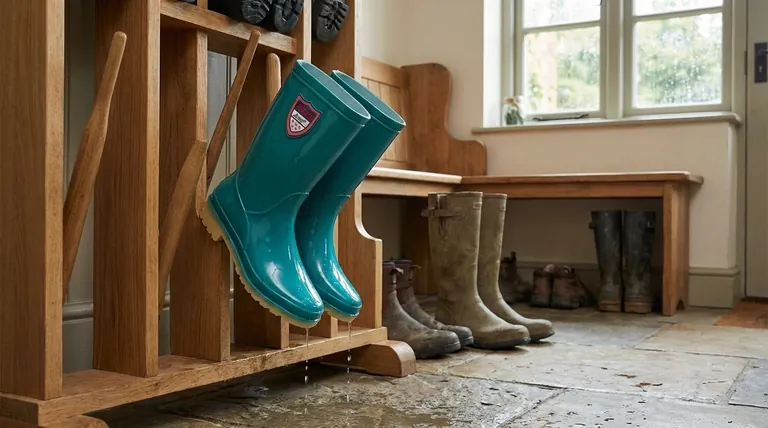The short answer is this: Storing Wellington boots upside down is a critical maintenance practice that prevents moisture buildup, protects the interior lining, and maintains the boot's structural shape. This simple habit stops the rubber from cracking and prevents the growth of mold or mildew, significantly extending the life of your boots.
Proper storage is not about tidiness; it is a fundamental aspect of gear care. Hanging your Wellington boots upside down actively prevents the material degradation caused by trapped moisture and physical stress.

The Core Principles of Proper Boot Storage
Understanding why upside-down storage works requires looking at the three primary threats to your boots: moisture, material fatigue, and environmental damage.
Preventing Moisture Buildup
Moisture is the primary enemy of any boot. Whether from rain, puddles, or sweat, trapped water inside a boot creates a perfect environment for bacteria, mold, and unpleasant odors.
Storing boots upright allows this moisture to pool at the bottom, soaking into the footbed and lining. Hanging them upside down uses gravity to ensure any water or condensation drains out completely.
Protecting the Interior Lining
Many Wellington boots feature a neoprene lining for insulation and comfort. This material is designed to be soft and flexible, but it can be damaged by constant dampness.
Airing out the lining is crucial. Upside-down storage promotes airflow throughout the boot's interior, allowing the neoprene to dry properly. This preserves its insulating properties and prevents the material from degrading or compressing over time.
Maintaining Structural Shape
The vertical shaft of a Wellington boot is prone to creasing and slumping if left unsupported. Tossing boots in a pile or leaving them to flop over creates stress points in the rubber.
Over time, these creases can weaken the material and lead to cracks. Storing them upside down, especially on a boot rack, keeps the shaft straight and free of folds, preserving the original design and preventing premature failure.
Understanding the Trade-offs
While hanging boots is ideal, any proper storage method is better than none. The key is to address the core risks.
The Problem with Tossing Them in a Corner
Simply leaving boots on the floor is the most common mistake. It traps moisture inside, encourages the shaft to collapse and crease, and invites pests or dirt to fall inside.
When You Can't Hang Them
If an upside-down boot rack isn't an option, you can still protect your boots. For long-term storage, ensure they are completely clean and dry first.
Then, insert boot shapers or loosely crumpled newspaper into the shafts. This helps maintain the shape and, in the case of newspaper, absorbs any residual internal moisture. Store them upright in a cool, dry place away from direct sunlight.
A Simple Checklist for Boot Longevity
Your storage method should adapt to how you use your boots.
- If your primary focus is daily use: Clean off mud and hang your boots upside down on a rack near a door. This ensures they drain and air out between wears.
- If your primary focus is seasonal storage: Clean your boots thoroughly inside and out, let them dry completely, and then store them upside down with newspaper inside to absorb any latent moisture.
Ultimately, treating your Wellington boots with care is the single best way to ensure they are ready and reliable when you need them most.
Summary Table:
| Storage Method | Key Benefit | Prevents |
|---|---|---|
| Upside Down | Drains moisture, promotes airflow | Mold, mildew, cracks, odor |
| Upright (with shapers) | Maintains shape if hanging isn't possible | Creasing, slumping |
| Tossed in Corner | (Not Recommended) | Traps moisture, causes damage |
As a large-scale manufacturer, 3515 produces a comprehensive range of durable footwear for distributors, brand owners, and bulk clients. Our production capabilities encompass all types of reliable Wellington boots built to last. Ensure your gear investment is protected with proper care. Contact our experts today to discuss durable boot solutions for your market!
Visual Guide

Related Products
- Factory Direct Wholesale Rain Boots Durable Waterproof & Fully Customizable
- Wholesale Safety Footwear Manufacturer for Bulk & Custom OEM Orders
- Factory-Direct Wholesale Canvas Boots with High-Traction Rubber Soles
- High Performance Fire-Retardant Waterproof Safety Boots
- Wholesale Waterproof Tactical Boots Custom Suede & High-Traction Soles
People Also Ask
- What variety of rubber boots is available? From Rain to Safety and Medical Solutions
- What are the main materials used in the production of rain boots? A Guide to Durability & Comfort
- What are the distinctive features of rain boots? Unmatched Waterproof Protection Explained
- What are the limitations of rain boots in certain climates? Find the Right Footwear for Your Weather
- What factors should be considered when choosing rain boots? Find the Perfect Boot for Your Needs



















